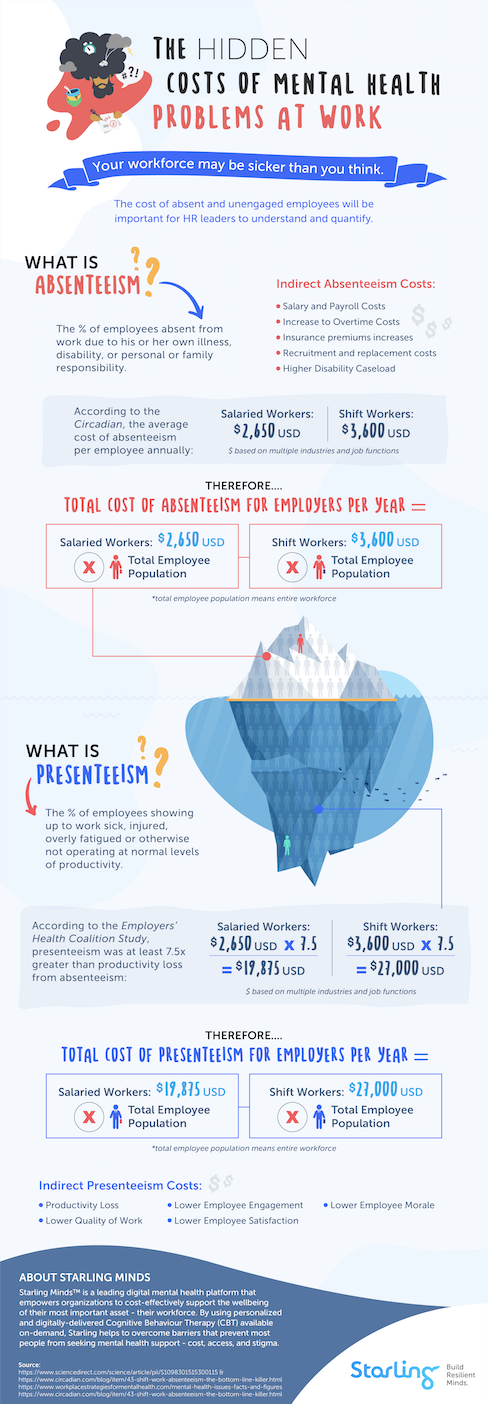Looking for Budget? What’s the cost if we don’t adopt a mental health solution?
There is a mental health crisis in healthcare organizations, and it’s gotten worse due to COVID-19. There are still shortages in PPEs, leaving many workers anxious and worried for their own safety, and their families. HR and disability teams that have taken positive steps now to improve employee mental health can not only improve the wellbeing and performance of burnt-out employees, but also potentially save millions of dollars in absenteeism and presenteeism.
How were Health Professionals Feeling before COVID-19?
Health professionals are thought to be naturally resilient. This can lead to an assumption that they can just “work through” any mental health issues. But research paints a different picture.
Before COVID-19, one in three physicians screened positive for depression¹, while 40% of physicians are in advanced stages of burnout². Forty percent of nurses fear to make mistakes due to a high degree of burnout³, and 14% of nurses have tested positive for post-traumatic stress disorder4.
Many health experts predicted these numbers have gotten worse due to COVID-19. This makes prioritizing mental health care in the workplace more important than ever.
The benefits of good mental wellbeing are well-known, including better patient outcomes, less absenteeism, more “present” staff, and higher productivity and performance.
What about the additional cost savings from improving mental health in your workplace? Absenteeism alone costs healthcare organizations a total of $80m a year for a workforce population of 30,000 and up. What is your organization’s contribution to that total?
What is absenteeism?
Absenteeism is an employee’s intentional or habitual absence from work without a good reason. While employers expect workers to miss workdays occasionally each year, excessive absences often equate to greater workforce disruptions, lower productivity, and a major drain to companies, its finances, and morale.
What is presenteeism?
Presenteeism occurs when employees are not fully functioning in the workplace due to an illness, injury, or other condition, but continue to perform their duties. This often equates to lower productivity and business performance.
Do you know the cost of absenteeism and presenteeism in your organization?
We’ve looked at the available research to give you an easy formula for calculating the hidden cost of absenteeism and presenteeism.
What Does Absenteeism Cost You?
According to a Circadian study, “Absenteeism: The Bottom-Line Killer,” unscheduled direct absenteeism costs around $2,650 USD/year or $3,537 CAD/year for each salaried employee —a total of $2.65m USD or $3.537m CAD for an organization with 1,000 employees.
- US: $2,650 x [# of employees] = Total Cost of Absenteeism
- Canada: $3,537 x [# of employees] = Total Cost of Absenteeism
What Does Presenteeism Cost You?
Although presenteeism is harder to track, studies found that presenteeism costs organizations 7.5x the rate of absenteeism, therefore $19,875 USD/year or 26,532 CAD/year for each employee—a total of $19.875m USD or $26.532m CAD for an organization with 1,000 employees.
- US: $19,875 x [# of employees] = Total Cost of Presenteeism
- CAD: $26,532 x [# of employees] = Total Cost of Presenteeism
How to Calculate the Hidden Costs of Mental Health Problems at Work
Here’s an infographic to help you visually see how to calculate your total mental health costs associated with absenteeism and presenteeism, as well as the top indirect costs associated. Taking the iceberg analogy, the cost of absenteeism is much more visible and trackable, although it’s just the tip as presenteeism is significantly more costly to organizations and difficult to see.
Infographic: How to Calculate the Hidden Mental Health Costs
How One Health Authority Reduced Absenteeism by 10% in Six Months
There is an urgent need for healthcare organizations to prioritize employee mental health. When it comes to budgeting, investigating solutions to managing and reducing absenteeism and presenteeism can save money that could be put to good use elsewhere.
Here’s how one organization did it:
One of the largest regional health authorities found that 41% of their employees admitted to suffering from poor mental health, and 40% of their disability costs have a primary mental health diagnosis. Despite signs of burnout, PTSD, and depression, fewer than 50% of employees sought treatment due to stigma, costs, and other reasons. Even employees who did seek help found it difficult to get it in a timely manner, or were denied access altogether by the benefits provider.
As a result, disability costs were rising annually yearly.
By coupling a digital platform with their existing face-to-face therapy programs, the health authority gave employees immediate access to effective mental health support. Within six months, absenteeism had decreased by 10%, along with associated cost savings and productivity improvements.
Mental Health Support for Healthcare Workers in Crisis
As COVID-19 swept across nations, Starling raced to launch our COVID-19 program dedicated to helping healthcare workers manage their mental health in times of crisis.
A Culture Transformation Leader at the regional health authority shares, “Our frontline staff have been at the forefront of this pandemic, and are working tirelessly to keep our patients and communities safe. It’s been amazing to have a partner like Starling Minds who goes the extra mile to provide this support to our staff in a time of crisis.”
Last Thoughts
While reducing absenteeism can take longer, presenteeism rates respond well to quick solutions. Studies show that when organizations take a human-centred approach to health, it can rapidly transform a workforce suffering from severe presenteeism.
Mobile digital solutions can empower employees to monitor and improve their own mental wellbeing on a daily basis. It’s just one of the ways HR and disability teams can combat the escalating mental health crisis in health care, for COVID-19 and beyond.
Learn how Starling is combating the mental health impacts of COVID-19: Starling Minds announced in a $2.5M Digital Technology Supercluster Project to deliver personalized mental health tools for frontline healthcare workers
Request a Demo





